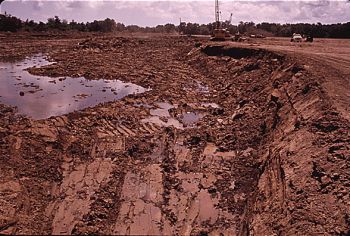Borrow Investigation

|
| Excavation of a borrow pit.
(Image Source: Wikipedia) |
Earthen embankment dams are most cost effective if the material is extracted from the proposed reservoir location. Not only are transportation costs of the material minimized, but the material volume can then be added to the total eventual water storage of the reservoir once filled. Additionally, sourcing the borrow material from within the proposed reservoir reduces the impact of excavation and extraction of native soils from locations that will not be inundated after filling of the reservoir.
Modern earthen embankment dams are designed using soils of varying hydraulic conductivities to construct discrete zones. These zones typically consist of a core having very low permeability, usually constructed using clays and silts, and a shell covering and protecting both upstream and downstream faces of the core consisting of sands and gravels with higher levels of permeability. The borrow investigation should aim to locate material suitable for such a multi-zoned earthen embankment dam.
“A systematic plan for selecting borrow areas should be followed during the feasibility investigation stage after final selection of the dam site. To avoid overlooking nearby areas, the investigations should start at the dam site and extend outward in all directions. Potential borrow areas near the dam should be investigated before more distant sources. Where possible, borrow from the proposed reservoir should be considered to mitigate environmental concerns”.[1]
“Investigation for embankment materials is a progressive procedure, ranging from a cursory inspection during the appraisal stage to extensive studies of possible sources of material during final design. A reconnaissance for borrow materials should be made at each prospective damsite. Careful examination of existing maps, soil surveys, aerial photographs, and geologic reconnaissance reports usually indicates the areas to be examined in the field. Highway and railroad cuts, arroyos, and banks along stream channels should be examined because they can provide valuable clues to the nature of the materials underlying a borrow area”.[1]
A material distribution plan should also be developed which accounts for waste, loss, shrink and logistics of placing the material in the dam with an adequate factor of safety on the volume of material available while also minimizing the amount of handling required. This can inform any contractual requirements that may need to be placed on the contractor in their development of the borrow to ensure that they can execute the project efficiently and effectively with the materials available.
Best Practices Resources
![]() National Engineering Handbook: Chapter 3 - Engineering Classification of Earth Materials, NRCS
National Engineering Handbook: Chapter 3 - Engineering Classification of Earth Materials, NRCS
![]() Design Standards No. 13: Embankment Dams (Ch. 10: Embankment Construction), USBR
Design Standards No. 13: Embankment Dams (Ch. 10: Embankment Construction), USBR
Citations:
Revision ID: 7295
Revision Date: 07/18/2023
